¿Te interesa realizar un curso online de tècnicas del tejido en telar con Anna Champeney?Si te interesa aprender técnicas de diseño y tejido en telar de bajo lizo online, escríbanos y suscribir a nuestro boletín.
 Contacta con nosotros | Collapse weave book by Ann Richards reviewed by Anna Champeney
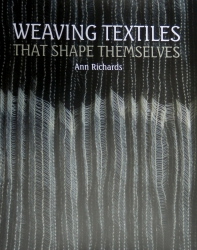 Cover photo Weaving Textiles That Shape Themselves ISBN 978 1 84797 319 1 by The Crowood Press 25 pounds sterling
This collapse weave manual is a comprehensive companion to Lotte Dalgaard´s new Magical Materials To Weave (Trafalgar), also a new publication for 2012. Both authors are experienced, experimental professional weavers with a passion for using active (elastic, overtwisted) yarns. It is a real pleasure to read a book based on serious research, with a wealth of authoritative information, and quality photographs of inspiring woven textiles. A suppliers list, bibliography and cross-referenced index are especially valuable, enabling readers to get the most out of the subject and learn more. Both books understandably focus on the properties of yarn, an understanding of which is fundamental for designing and weaving collapse textiles. Richards´ book is particularly good on explaining about type of spin and the phenomenon of tracking and is comprehensive in its coverage of sett and structure including double weave. Another strength of Richards´ book is her inclusion of stunning work by other prominent weavers worldwide, including Deirdre Wood, Junichi Arai, Reiko Sudo (Nuno). The reversable bag by Junichi Arai (woven in four layers which is completely self-forming) is a good example of the way this Japanese designer relishes technical challenges in weaving. Weaving Textiles That Shape Themselves starts and finishes with the theme of woven textile design. Too often weave books are based on formulas or drafts and cloth swatches which inevitably encourage one to copy rather than innovate. This goes hand-in-hand with another problem in the weaving world which is the lack of opportunitites to learn design skills (I see this in non-English speaking countries like Spain and Latin America, for example). Personally, I was lucky in learning about the importance of sampling from Francisca Pellisca, the Catalan weave artist, who gave me my first introduction to cloth drafting, and so right from the beginning I just assumed that whenever I started a new weave project I would incorporate a section of warp for experimenting, the results of which would lead onto a final, more worked, design. Twelves years on from then and the baskets of samples have become an important reference collection for my own work – it is never enough to have comprehensive written records to refer back to. As Richards comments, this approach of sampling is by no means standard amongst weavers but if the world of constructed textiles is to move on it needs to nurture and promote the idea of weave design as a core skill that all weavers learn – whether as professionals or home weavers. Otherwise standards will drop, the collective body of knowledge will shrink, the sector will lose prestige and visibility and weave be consigned to the status of formula-based hobbycraft rather than as a serious, constantly evolving profession. The chapter “Designing as a Conversation” contains useful pointers for all weavers interested in designing themselves, with straight-forward and practical information, alongside images of Richards´ own work, including her signature pieces – highly sculptural neckpieces. In view of the philosophy behind the book it comes as no surprise that Richards´ book does not contain projects or fabric recipes, but it is clearly aiming at creating a readership that is more interested in acquiring the fundamental knowledge behind collapse weave to empower themselves to develop their own designs. It almost goes without saying that this is not a book for beginners but it is essential reading for those weavers of intermediate to advanced level who are fascinated by the properties of yarn and the incredibly complex interaction with woven structure. This is a book which will inspire and raise standards and should be standard reading on constructed textile courses. Exhibition of collapse textiles in Handweavers´ Studio, London 18 May – 13 June 2012“Minstrel II” Scarf
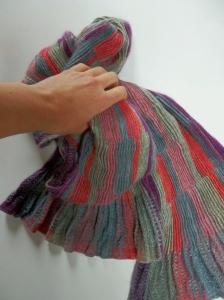 Angora collapse scarf "Minstrel II" by featured artist in exhibition at Handweavers´ Studio 18 May - 13 June 2012
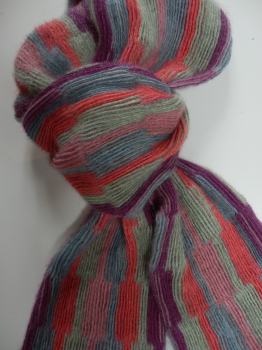 This exhibition features work by Ann Richards and Lotte Dalgaard as well as other artists featured in Weaving Textiles That Shape Themselves. The show isorganised to coincide with the double book launch. This exhibition features work by Ann Richards and Lotte Dalgaard as well as other artists featured in Weaving Textiles That Shape Themselves. The show isorganised to coincide with the double book launch.
Here you can see one of the exhibits, new work by Anna Champeney Estudio Textil, together with interesting background information about how the piece was designed and woven. This piece is available for sale. Price.
- 200cm x 16cm
- Cord weave with reversed weave structure
- Natural dyed angora, alpaca, wool (indigo, copper, cochineal), corneta transparent yarn and high twist wool
Weave Tuition / Weave retreats at Anna Champeney Estudio Textil, SpainAnna Champeney Estudio Textil offers residential weave tuition at the studio itself, set in a picturesque village amidst stunning mountain scenery in northwest Spain (nearest airports: Santiago de Compostela, A Coruña). 8-shaft table looms and yarns (linen, angora, wool) are also available for hire for those wishing to combine a holiday with a weave retreat. Self-catering accommodation is available in Casa dos Artesans, the simple but comfy cottage adjacent to the weave studio (2 – 5 people). The area offers good walking, thermal spas and historic monasteries and castles, plus local bars serving simple, home-cooked fresh food and local wine. To contact the studio directly click here.
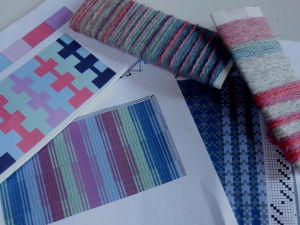 Preliminary design work by Anna Champeney Estudio Textil for Minstrel II includes cloth drafting on Weavepoint, yarn wraps and colour-design tables. The design was based on earlier experiments in cord weave with fairly thick angora, alpaca and wool warp which was hand-dyed with indigo, copper and cochineal. Various samples were woven to test out different effects with different active and stable yarns.
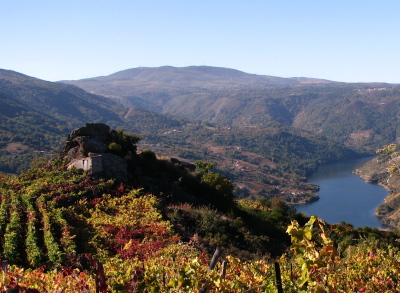 View from the village of Cristosende, where Anna Champeney Estudio Textil is situated in Galicia, northwest Spain
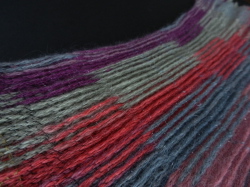 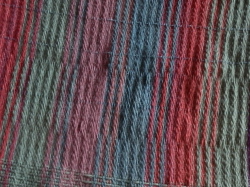 Sampling is an important part of the design process. Different combinations of weft yarns and densities were trialled. In the end the piece used corneta transparent (Danish Yarn Purchasing Association, www.yarn.dk) and a high twist wool in the weft. The second photo shows what the textile design looks like prior to wet finishing, when just cut from the loom.
Just off the loom – Natural dyed silk scarves in waffle weave – available to buy now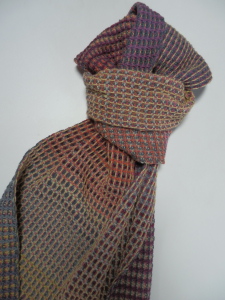 Photo of silk waffle weave scarf by Anna Champeney (ref. 50/50 Laura-F.A.). This special version features numerous colour changes which give it a shimmering effect. This is a non-repeatable, one-of-a-kind piece. SOLD Limited series with unique colourways on each scarf, hand-woven from 50% sillk, 50% wool, with other similar versions with angora, cashmere. Prices range between 95€ – 185€. Information on request.
Eco-friendly fabrics from Spain
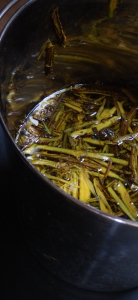 Barberry bark, one source of local and natural colour at Anna Champeney Estudio Textil (April 2012)
Barberry bark, madder root, dried cochineal and walnut husks are all sources of natural colour used to create the textiles at the weave studio of textile designer Anna Champeney in north Spain. The studio´s collections include limited edition double-weave linens, double-sided scarves in richly-coloured silk and wool, and a range of linen and wool textiles for interiors, including cushions, storage bags and decorative wall-dividers. The designs vary with each collection but what unites all these textiles is the rich and harmonious use of natural colour. The reality is that the colours produced by natural dyes are different to most synthetic dyes today because the complex formulas of natural plant dyes – a single plant may contain several dyes which combine to produce a particularly rich or subtle colour – are usually too expensive to produce in the context of industrial textile production.
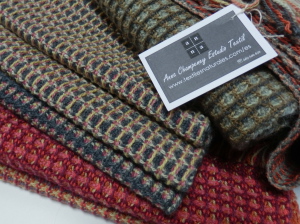 Anna Champeney textile collection 2011-12 - waffle weave scarves in silk and wool with natural dyes
This makes natural dyes the ideal choice for certain designers and specialist artisans who seek to produce a high-end product and who also care about the way that textiles are made today and the impact on the natural world. “I started working with natural dyes as it seemed the obvious choice given the location of the textile studio in rural north Spain where there was an abundance of natural dyestuffs. Of course, I was also interested in making a more organic or natural product. For me this meant sourcing dyestuffs as locally as possible, using processes which were efficient, with little waste, and avoiding chrome as a fixative ” commented Champeney.
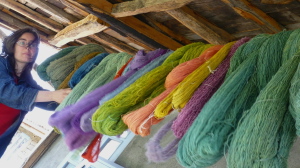 Drying yarns dyed with lichen, gorse, indigo and madder at Anna Champeney Estudio Textil in north Spain
The quality of the colours produced was also a factor. “As a textile designer and craft weaver you often find yourself limited by the commercial colour ranges. By dyeing my own colours I can achieve incredibly varied and subtle colour blends which lend a special quality to the finished textiles. This gives me a certain freedom which industrial designers simply do not have”. Marta Bahillo – Spanish knit designer – opts for natural dyes
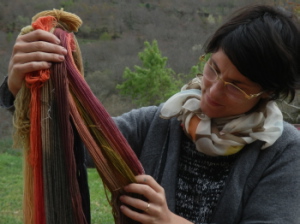 Marta Bahillo, Spansh knit designer, discovers the subtle colours of natural dyes
Marta Bahillo, a young Spanish knit designer is also moving in this direction which was why she decided to spend time at AC Estudio Texil for some intensive colour tuition. Working with natural dyes for the first time was nothing short of a revelation for this designer, whose working practice up until now always involved off-the-peg synthetically-coloured yarns. “I really feel the course has changed me because I see colour in a different way now”, commented Bahillo, “I can see subtle changes in tone which I didn´t notice before”. Moreover, Bahillo was particularly struck by the sheer variety and richness of the colours obtained using natural dyes. In the context of her work as a knit designer Bahillo sees definite advantages in being able to have a greater control over the final result. Working directly with the dyes gives her a far greater creative involvement in the process, leading her to comment “As a textile designer I feel more confident than before”. Natural Dyes and Fashion But what about the dictates of fashion which result in certain colours dominating the market every year. Is it important for these new designers to look at colour forecasts for fashion? Champeney thinks not. “My clients tend to have a confidence in their own sense of style and colour and choose colourways which suit them rather than to follow the dictates of the fashion industry. They may combine my textiles with clothing from branded fashion but their style is definitely an individual style which is unique to them. The challenge for independent designers or makers not to follow fashion but to make textiles which are so distinctive and beautiful that each piece becomes a personal classic in its own right”. More information:
- Inquiries about Anna Champeney Estudio Textil´s limited edition textile collections – please contact the studio.
- Textilesnaturales hopes to feature Marta Bahillo again in a future feature.
New video link of collapse weave! Pleated, crinkled and specially-textured fabics are all possible with the exciting technique of collapse weave, promoted in the wonderful book for hand-weavers, Magical Materials by Danish master weaver Lotte Dalgaard as well as in the the publication Collapse Weave by Anne Field. 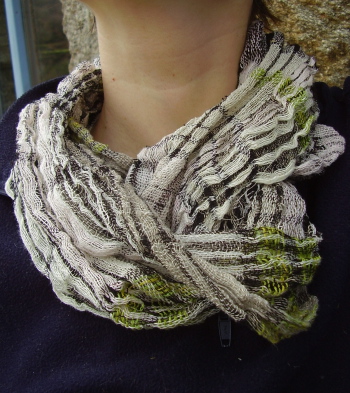 Collapse weave technique using active and stable yarns (scarf by Anna Champeney Textile Studio) Here you can follow a video link to a video on YouTube showing Spanish-based weaver Anna Champeney, pupil of Lotte Dalgaard, demonstrating the technique and yarns used, to show you the kind of textiles that are possible. In the video clip Anna uses supertwisted wool yarn available from Handweavers´ Studio and the Danish Yarn Purchasing Association, in conjunction with 12/2nm linen as warp and an incredibly fine 100/1nm line (100,000m/k) as weft. A limited stock of this unusually fine linen weaving yarn is currently available directly from Anna Champeney textile studio (26,50€ for approx. 260g). Buy 100/1 nm linen yarn online. Collapse weave video with Anna Champeney Buy Magical Materials book by Lotte Dalgaard Additional information about collapse weave textiles by Lotte Dalgaard, Danish master weaver Other linen yarns available from ACEstudio Textil Exclusive collapse textiles from ACEstudio Textil Many thanks to Diana and James Jackson who who visited the Textile Studio from the UK and recorded this impromptu video – in just one take – of Anna at work in her studio and uploaded the video to Youtube |
Pago seguro
 NUEVO Octubre 2023 Curso presencial setmanal de teixits de baix lliç (Girona)!Un curso nou, setmanal (3h) a Sant Gregori, Girona, amb l'Anna Champeney. Trimensual, plaças limitadas).
Octobre 2023. Ven a aprender a diseñar y realizar tejidos en telar de bajo lizo a mano. Docente: Anna Champeney, profesional desde 2004, con marca textil propia, experta en tejido de bajo lizo, docente en la Escola Massana, Barcelona.
 Haga clic aquí para informarte |











Weaving Textiles That Shape Themselves by Ann Richards – Exhibition and book launch in London May 2012
Collapse weave book by Ann Richards reviewed by Anna Champeney
Cover photo Weaving Textiles That Shape Themselves ISBN 978 1 84797 319 1 by The Crowood Press 25 pounds sterling
This collapse weave manual is a comprehensive companion to Lotte Dalgaard´s new Magical Materials To Weave (Trafalgar), also a new publication for 2012. Both authors are experienced, experimental professional weavers with a passion for using active (elastic, overtwisted) yarns. It is a real pleasure to read a book based on serious research, with a wealth of authoritative information, and quality photographs of inspiring woven textiles. A suppliers list, bibliography and cross-referenced index are especially valuable, enabling readers to get the most out of the subject and learn more. Both books understandably focus on the properties of yarn, an understanding of which is fundamental for designing and weaving collapse textiles. Richards´ book is particularly good on explaining about type of spin and the phenomenon of tracking and is comprehensive in its coverage of sett and structure including double weave. Another strength of Richards´ book is her inclusion of stunning work by other prominent weavers worldwide, including Deirdre Wood, Junichi Arai, Reiko Sudo (Nuno). The reversable bag by Junichi Arai (woven in four layers which is completely self-forming) is a good example of the way this Japanese designer relishes technical challenges in weaving.
Weaving Textiles That Shape Themselves starts and finishes with the theme of woven textile design. Too often weave books are based on formulas or drafts and cloth swatches which inevitably encourage one to copy rather than innovate. This goes hand-in-hand with another problem in the weaving world which is the lack of opportunitites to learn design skills (I see this in non-English speaking countries like Spain and Latin America, for example).
Personally, I was lucky in learning about the importance of sampling from Francisca Pellisca, the Catalan weave artist, who gave me my first introduction to cloth drafting, and so right from the beginning I just assumed that whenever I started a new weave project I would incorporate a section of warp for experimenting, the results of which would lead onto a final, more worked, design. Twelves years on from then and the baskets of samples have become an important reference collection for my own work – it is never enough to have comprehensive written records to refer back to.
As Richards comments, this approach of sampling is by no means standard amongst weavers but if the world of constructed textiles is to move on it needs to nurture and promote the idea of weave design as a core skill that all weavers learn – whether as professionals or home weavers. Otherwise standards will drop, the collective body of knowledge will shrink, the sector will lose prestige and visibility and weave be consigned to the status of formula-based hobbycraft rather than as a serious, constantly evolving profession. The chapter “Designing as a Conversation” contains useful pointers for all weavers interested in designing themselves, with straight-forward and practical information, alongside images of Richards´ own work, including her signature pieces – highly sculptural neckpieces. In view of the philosophy behind the book it comes as no surprise that Richards´ book does not contain projects or fabric recipes, but it is clearly aiming at creating a readership that is more interested in acquiring the fundamental knowledge behind collapse weave to empower themselves to develop their own designs.
It almost goes without saying that this is not a book for beginners but it is essential reading for those weavers of intermediate to advanced level who are fascinated by the properties of yarn and the incredibly complex interaction with woven structure. This is a book which will inspire and raise standards and should be standard reading on constructed textile courses.
Exhibition of collapse textiles in Handweavers´ Studio, London 18 May – 13 June 2012
“Minstrel II” Scarf
Angora collapse scarf "Minstrel II" by featured artist in exhibition at Handweavers´ Studio 18 May - 13 June 2012
Here you can see one of the exhibits, new work by Anna Champeney Estudio Textil, together with interesting background information about how the piece was designed and woven. This piece is available for sale. Price.
Weave Tuition / Weave retreats at Anna Champeney Estudio Textil, Spain
Anna Champeney Estudio Textil offers residential weave tuition at the studio itself, set in a picturesque village amidst stunning mountain scenery in northwest Spain (nearest airports: Santiago de Compostela, A Coruña). 8-shaft table looms and yarns (linen, angora, wool) are also available for hire for those wishing to combine a holiday with a weave retreat. Self-catering accommodation is available in Casa dos Artesans, the simple but comfy cottage adjacent to the weave studio (2 – 5 people). The area offers good walking, thermal spas and historic monasteries and castles, plus local bars serving simple, home-cooked fresh food and local wine. To contact the studio directly click here.
Preliminary design work by Anna Champeney Estudio Textil for Minstrel II includes cloth drafting on Weavepoint, yarn wraps and colour-design tables. The design was based on earlier experiments in cord weave with fairly thick angora, alpaca and wool warp which was hand-dyed with indigo, copper and cochineal. Various samples were woven to test out different effects with different active and stable yarns.
View from the village of Cristosende, where Anna Champeney Estudio Textil is situated in Galicia, northwest Spain
Sampling is an important part of the design process. Different combinations of weft yarns and densities were trialled. In the end the piece used corneta transparent (Danish Yarn Purchasing Association, www.yarn.dk) and a high twist wool in the weft. The second photo shows what the textile design looks like prior to wet finishing, when just cut from the loom.
Just off the loom – Natural dyed silk scarves in waffle weave – available to buy now
Photo of silk waffle weave scarf by Anna Champeney (ref. 50/50 Laura-F.A.). This special version features numerous colour changes which give it a shimmering effect. This is a non-repeatable, one-of-a-kind piece. SOLD
Limited series with unique colourways on each scarf, hand-woven from 50% sillk, 50% wool, with other similar versions with angora, cashmere. Prices range between 95€ – 185€. Information on request.